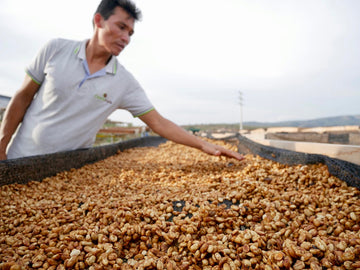What is Honey Processed Coffee and Why is it so Delicious?
par Equator Coffee Roasters sur Feb 03, 2021

Our Peru Huabal microlot is made up of a special selection of honey-processed coffee that comes from a group of 12 dedicated, talented farmers within the CENFROCAFE cooperative.
So, what does “honey processed” mean exactly? First off, honey-processed refers to the way the raw beans are treated at the farm before they get exported to the North. Coffee beans grow in cherries on trees. The cherries are picked and the pulp is generally removed within hours of being pick (“natural processed” or unwashed coffee is a whole other story - see below!) Once the pulp of the coffee cherry is removed, the mucilage (the sticky, sugary layer that surrounds the coffee bean - hence, “honey”!) stays on the bean instead of being washed off as in the typical washed coffee process. This gives the raw material a slightly golden colour (instead of the usual green bean in washed coffee) and infuses the bean with a notable sweet and honey-like flavour. For those who might be hesitant in a coffee that tastes like honey, fear not: the word refers more to the colour of the raw bean as well as the sweetness resulting from the process. The overall flavour infusion is subtle and delicate and not overly honey specific.
In this post, you will learn how coffee is harvested, how the coffee cherries are processed, and what sets honey-processed coffees apart.
Coffee Harvest
Coffee plants grow at high-elevation in countries around the equator: from Central and South America, to Africa, and Southeast Asia. When the coffee plant reaches maturity, it begins to bear fruit, known as cherries. The cherries transition from green to yellow and when they become red they are ready to harvest. The pit of the cherry is what we’re after - that’s the coffee bean. The coffee bean is covered in a sticky mucilage, which is within the pulp of the cherry.
When the cherries are ready to be harvested, farmers will hand pick and collect the ripe coffee cherries. The farmers will return multiple times over a few weeks to harvest cherries as they ripen. This labour-intensive process is known as selective picking and is reserved for only the most high-quality coffee (Arabica) - it all gets done by hand only. Lower grade coffee such as Robusta will be strip-picked which is exactly as it sounds. All the cherries will be stripped from their plants and sorted later. This is damaging to the plant and the ecosystem.

Now that the coffee has been harvested, the farmers need to prepare the coffee bean for selling, this is known as processing. The two most common methods for processing are washed and natural.
Washed
“Washed” coffee otherwise known as the “wet method” is the most common method for processing coffee. Within 24 hours of getting harvested, the cherries are carried by water and pass through a pulping machine which presses the cherry to remove the pulp from the bean. The beans are then sorted and stored in fermentation tanks for up to 48 hours to naturally remove any remaining mucilage from the papery parchment. The beans will then be dried, either by the sun (like the photo below) or in mechanical dryers.

Unwashed
"Natural" processed coffee, also known as "sundried” or "unwashed" follows a different process. Instead of immediately taking the pulp off the coffee cherry as is done with "washed" coffee, this process dries the coffee without depulping and hulls it after it's completely dry. Leaving the fruit on the pit during the drying process allows it to pick up all the fruity flavours of the pulp. Naturals are known to have pronounced flavours such as blueberry muffin, strawberries, and wine.

Honey Processed
Honey processed coffee gets de-pulped like in the ‘washed’ method, but instead of removing the sticky mucilage in the fermentation tanks, they go immediately to the drying beds. The remaining mucilage is sticky, sweet, and golden - just like honey. Hence the name! Beyond being delicious, this also benefits coffee producers by using less water than washed processing. Honey processed coffees bare more complexity than washed coffees, but tend to be less fruit-forward than natural coffees.
We are so excited for you to try our latest release from the Huabal region of Peru. This light roast has notes of cherry and dark chocolate that are perfectly complemented by the honey sweetness. Available in stores and online while supplies last!
